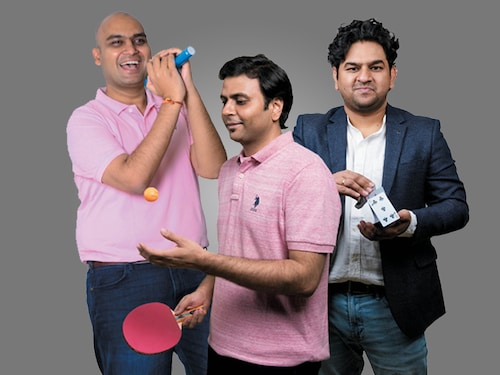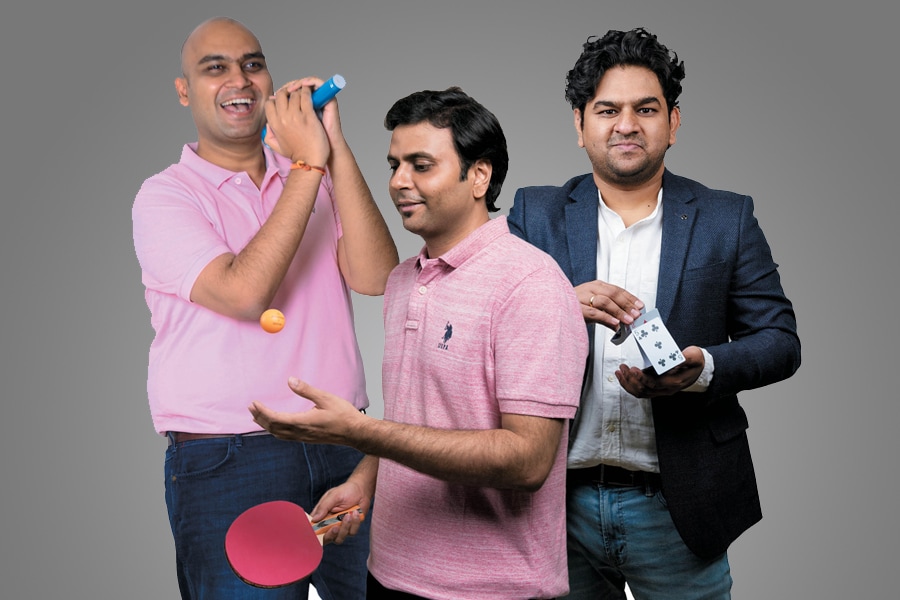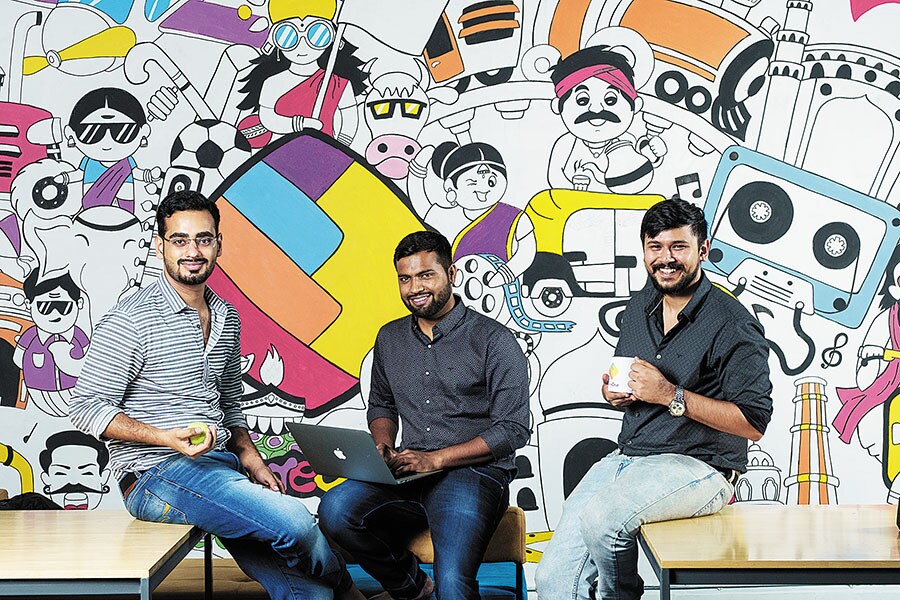Roposo vs ShareChat: Which will replace TikTok?
Roposo and ShareChat lead a bunch of local contenders that have emerged after the ban on Chinese apps


 (From left) Mayank Bhangadia, CEO and co-founder, Roposo, Kaushal Shubhank, co-founder and CTO, Roposo, and Avinash Saxena, co-founder, Roposo
(From left) Mayank Bhangadia, CEO and co-founder, Roposo, Kaushal Shubhank, co-founder and CTO, Roposo, and Avinash Saxena, co-founder, Roposo
Images Kaushal: Amit Verma Avinash: Nishant Ratnakar for Forbes India
Hours after the government banned 59 China-made apps citing national security concerns, Roposo’s engineers were in a tizzy. Branded as “India ka apna video app” or India’s own video app, the short video-sharing platform, akin to TikTok, the wildly popular Chinese app that counted 200 million users in India until the ban, saw a sudden rush of users.
“It was crazy… our servers got jammed and we had to quickly upgrade them to deal with the increased traffic,” says Avinash Saxena, co-founder at the Gurugram-based startup which was acquired by advertising tech unicorn InMobi late last year. Daily active users rocketed from 6 million before the ban to 17 million just days after the ban, says Naveen Tewari, InMobi’s chief. At the time of writing, Roposo claims to have been downloaded 80 million times. “This is India’s digital atmanirbhar moment,” he beams.
Sure enough, a number of local short video-sharing platforms rushed to fill the void left by TikTok, including Chingari, Mitron and Rizzle. As did entrenched players like ShareChat and Instagram. But only one or two platforms will come out on top, say industry bosses.
Back in 2014, along with his IIT-Delhi mates, Mayank Bhangadia and Kaushal Shubhank, Saxena founded Roposo as a social network focussed on fashion. It allowed users to discover and share the latest trends in clothing and accessories via a chat-like interface. “We soon realised that video was the default mode in which users were sharing stuff,” says Saxena. So the trio turned their attention to videos and expanded beyond fashion.
This pivot to videos came in August 2017. “It was around the time that Instagram was taking routes in India,” says Anand Lunia, founding partner at India Quotient, an early investor in Roposo. “When we invested [in 2014], it was the early days of smartphones and the internet in India Instagram was not popular either. Roposo was India’s first social network app and our mandate at IQ has always been to invest in 2 to 3 social media startups with the aim of discovering the next Facebook from India. Besides, Roposo had a good technical team,” he says.
Soon after the shift to user-generated videos on topics ranging from comedy to religion and sports to singing, Tiger Global Management, Flipkart’s Binny Bansal and India Quotient invested $5 million in the startup’s Series A fundraise in February 2015.
With the fresh funds, Roposo grew its video platform and also decided to experiment with commerce, but the latter failed. “They burnt most of their money with that, but Tiger extended another lifeline to them,” says one industry insider on condition of anonymity. The New York-headquartered hedge fund invested another $15 million in Roposo in August 2015, according to data from Venture Intelligence. The startup continued its focus on videos, including local languages, while still attracting capital from Tiger which led the startup’s Series C and D rounds in November 2018 and May 2019, respectively. But competition from ByteDance owned-TikTok, which burst on to the scene in August 2018, was stiff.
In November 2019, Roposo, which claimed 42 million users at the time for its multichannel, multilingual TV-like offering, was acquired by Glance, an arm of InMobi. The financial details of the transaction weren’t disclosed, but according to the industry insider quoted above, it was an acquihire. “The founders perhaps got a pay-out, but the investors got nothing. They lost money,” he says.
For Tewari, the synergies were obvious. Glance, which had raised $45 million from Peter Thiel’s Mithril Capital shortly before the Roposo deal, delivers personalised content on the locked mode screens of smartphones. “Majority of Android phones use our technology,” says Tewari. Roposo would bring to Glance additional content, its community of creators and influencers, and an experienced team. Glance, in turn, would further the reach of Roposo’s videos given its massive scale. “With more than 100 million daily active Glance users, content created on Roposo naturally flows into Glance and creates a flywheel effect,” says Tewari.
Thanks to the ban, that effect has now multiplied. “We had around 50 million downloads before the ban. Now we have close to 80 million,” says Saxena. While there’s a lot of work to be done, he says, Roposo’s video technology, including its camera and creation tool, painstakingly built and refined over the years, is a strong differentiator. Moreover, because of the synergies between Roposo and Glance, says Tewari, “you can go from being a star to a superstar. Our ability to make money for our creators is very high”. Content creators on Roposo get paid in redeemable points for every view of their videos, as opposed to TikTok, where users monetised their content through brand associations.
ShareChat, the regional language social network which competed directly with Helo, another ByteDance-owned app, was in a similar frenzy right after the ban. “Moj [ShareChat"s short video-sharing offering] was built within a couple of days of the ban and we"ve seen incredible growth with a number of influencers and top creators joining the platform,” says Berges Malu, ShareChat’s head of public policy. The app saw 2.4 million downloads within two days of it going up on Google’s Play Store, according to Entrackr. “We will have other big announcements to make when we officially launch the app soon,” adds Malu. Till then the startup is busy refining its video creation tools, obtaining music licenses and building up its community of creators.
ShareChat, which has seen daily active users jump 3x from 12 million to 35 million since the ban and has so far raised $230 million, also plans to announce another fundraise in week or so, sources tell Forbes India. Its parent company Mohalla Tech had raised $100 million in Series D funding in August last year with Twitter and TrustBridge Partners as new investors. Existing investors Shunwei Capital, Lightspeed Ventures, SAIF Capital and India Quotient also participated in the round, valuing the company at an estimated $650 million.
Not to be left behind, Facebook owned-Instagram launched Reels, its TikTok-like short video offering, 10 days into the ban. In fact, immediately after the ban, Instagram, which has roughly 70 million daily active users, started reaching out to TikTok’s popular creators and influencers to persuade them not to join any platform. “They told us not to join any other platform as they would be coming out with one in a week or so,” a former top-grossing TikToker with over 5 million followers tells Forbes India on condition of anonymity. “If all the good video creators come together and go to one app, that’s better for all of us. So I’d rather take my time, think it through and go to a platform where my brand value will not diminish.” He has since started posting videos on Reels.
“The difference between Instagram and ShareChat is that of India versus Bharat. ShareChat and others are going after Bharat, while Instagram targets the affluent but numerically few users in urban India. There"s a market for both," says the insider quoted above. Lunia of India Quotient, which seeded ShareChat with `50 lakh back in February 2015, further points out that ShareChat was among the first to foray into the regional language space and so “deeply understands” its audience.
Meanwhile, TakaTak by Times Internet-owned MX Player is also emerging as a key contender to replace TikTok. Not just is the app’s name similar to that of the Chinese offering, but so is its user interface. The top free apps ranking on Google’s Play Store shows TakaTak trending at the number two position at the time of writing. Moj is just behind at number three while Roposo is at number eight. Instagram stands at number 12.
Interestingly, the top place is taken by Snack, a short video platform launched by China’s Kuaishou Technology in April this year. This is the Tencent-backed company"s second short video app after one called "Kwai", which was one of the 59 apps banned by the government. “A lot of these Chinese companies have more than one platform. So while one has been banned, they are now pushing their other platforms,” says one investor on condition of anonymity. “We might see another round of bans on such apps.”
 (From left) ShareCart Co-founders Ankush Sachedeva, Bhanu Pratap Singh, Farid Ahsan have built short video-sharing platform Moj
(From left) ShareCart Co-founders Ankush Sachedeva, Bhanu Pratap Singh, Farid Ahsan have built short video-sharing platform Moj
As Roposo, Moj, TakaTak and Instagram battle for dominance, what will it take to win? For one, capital. According to one industry insider, ByteDance, bankrolled by SoftBank, pumped in $20 to $30 million a month into India to grow TikTok. “You need large amounts of capital to grow in this business,” says Sanjay Mehta, an early stage investor. A case in point being Chingari and Mitron. Both short video-sharing apps rode the anti-China wave in the aftermath of the ban. They were among the most downloaded apps on the Google Play Store. "Welcome on board Bharat! Let"s go to 100 million users this month! 11 million in 22 days! Super excited," tweeted Sumit Ghosh, co-founder and chief of product and growth of Bengaluru-based Chingari on July 2. Likewise, Mitron boasted of 23 million users by July 4, according to a tweet by the company. It said that it had taken 70 days to cross the 10 million download threshold, but less than three days to double it. Play Store rankings at the time of writing shows Chingari languishing at 75th position, while Mitron didn’t even make it to the top 100.
“Apps that have suddenly come on to the scene are bound to fizzle out,” says Lunia. “You need at least $150-$200 million to survive in this business,” he says.
Meanwhile, Roposo, backed by the SoftBank-funded InMobi, presently has the funds it needs to grow, says Tewari. Instagram too has the deep pockets of Facebook to fall back on.
Second, to succeed in this business, platforms need a strong community of creators. Mehta cites the importance of the “network effect” where more creators leads to more content, which leads to more users. More users, in turn, demand more content, which spawns more creators. “Virality is crucial for such businesses. Only then will you see an avalanche of users,” he says.
Put another way, creators will be attracted to platforms that are able to bring them fame by way of number of views, and brand associations or redeemable cash rewards. Users on the other hand, fickle as they are, will be glued to platforms that offer quality content, and provide engagement by way of campaigns or competitions.
Third, technology is key for success. TikTok’s personalised recommendation algorithm kept users hooked, says Lunia. For any platform to replicate that its machine-learning and artificial intelligence capabilities need to be on point.
Even with a combination of capital, community and technology, challenges remain. The investor quoted above cites the lack of engineering talent in the country when it comes to building social media products. “If you need some inventory management software you’ll get all the talent you want because that’s what Infosys built up over the years. But we’ve never built a social media platform prior to this,” he says.
The biggest threat, however, is the government opening up the market to the banned Chinese apps. “Imagine pumping in all this money into their apps and then the Chinese return. They [local apps] will all be in a hot soup,” says the same investor.
Luck, as it were, is another component for success.
First Published: Jul 29, 2020, 11:02
Subscribe Now